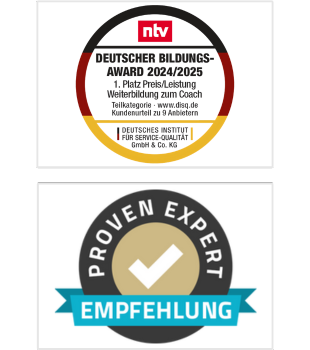Are We There Yet?
Abschlussarbeit von Dr. Annika Nübold, als PDF lesen
Workplace coaching is one of the fastest growing fields within consulting (Liljenstrand & Nebeker, 2008) and has become an integral part of human resource development portfolios in many organizations (Bozer & Delegach, 2019). Workplace coaching can be defined as a developmental, tailor-made intervention in which a professional coach (internal or external; Bozer & Jones, 2018; Passmore & Lai, 2020; Smither, 2011) utilizes collaborative, reflective, and goal-oriented strategies to facilitate the development and performance of individuals or groups in organizations (Athanasopoulou & Dopson, 2018; Bozer & Jones, 2018; Grant, 2017). Workplace coaching has become a multibillion- dollar global market (Armstrong, 2011) with an estimated 71,000 professional coaches in 2019 worldwide, an increase of 33% on the 2015 estimate (International Coach Federation, 2020). Whereas coaches had mainly been hired to address toxic issues in leadership, they are nowadays mostly hired to develop high-potential performers or support the transition to a leadership role (Athanasopoulou & Dopson, 2018; Coutu et al., 2009).
Despite the high demand and popularity of workplace coaching, the field is still in the process of gaining professional credibility, partly due to stark differences in coaching practices and coaches’ background (Athanasopoulou & Dopson, 2018; Drake, 2008). This issue is also reflected in research where the field has long been criticized for its lack of robust study designs and rigorous empirical evidence (Silzer et al., 2008). The majority of articles still consist of case studies or descriptive papers that highlight the benefits of a certain approach or technique (De Meuse et al., 2009). In a recent systematic review by Athanasopoulou and Dopson (2018), only 32 out of 110 peer-reviewed studies on executive coaching were published in journals with an impact factor and only 15 used a robust quantitative research design, such as randomized controlled trials (RCTs) or quasiexperimental designs.
Although the quality of research has increased considerably during the past five to ten years (Bachkirova, 2017; Kotte, 2019), further theoretical grounding and knowledge, particularly on the mechanisms and contextual boundary conditions that drive and influence coaching effectiveness, are highly needed (Athanasopoulou & Dopson, 2018; Bozer & Jones, 2018; Grover & Furnham, 2016). For example, there is still a lack of clarity regarding the drivers of coaching effectiveness (i.e., the psychological mechanisms) and the boundary con- ditions that boost or hinder coaching success (e.g., coach and coachee characteristics, the role of the organizational context; Bozer & Jones, 2018; Jones et al., 2016). To date, the field has been preoccupied with the question whether coaching works but has largely ignored the questions of why and when it works (Athanasopoulou & Dopson, 2018). Furthermore, the field is still not entirely clear about what factors define coaching effectiveness, i.e., what outcomes should be measured and evaluated (De Haan et al., 2013).
While most research has focused on outcomes on the individual level of analysis (e.g., improvements in coachees’ selfefficacy or behavior), benefits on a group or organizational level (e.g., team satisfaction, productivity) have rarely been considered yet.
In the present work, after providing a more extensive definition of workplace coaching, I will review and summarize the current state of research regarding its effectiveness. Then, I will shortly discuss potential unwanted side effects of workplace coaching that may occur during or after the coaching process. I will conclude with a set of open and yet unresolved questions in this field of inquiry and suggestions for future research which could help to further increase the field’s credibility and scientific maturity.
Workplace Coaching – A Definition
Generally, coaching can be defined as a “result-oriented, systematic process in which the coach facilitates the enhancement of life experience and goal-attainment in the personal and/or professional life of normal, non- clinical clients” (Grant, 2003, p. 254). Thus, coaching differs from therapy as it does not address mental health problems (De Haan et al., 2013) but also from mentoring, counselling and other conversation-based approaches to change as coaching helps individuals to learn rather than teaching them (Passmore et al., 2018; Whitmore, 2002). Coaching is a systematic learning and development approach that is characterized by a collaborative, reflective, goal-focused relationship between coach and coachee. Coaching puts coachees as learners at the center of the coaching experience, thereby aiming to promote their self-awareness and personal responsibility and unlock their full potential (Passmore & Fillery-Travis, 2011). In general, coaches use a wide variety of cognitive, motivational, and behavioral techniques to help the coachee achieve a mutually identified goal. Those techniques typically facilitate goal attainment by asking open questions (Passmore & Fillery-Travis, 2011; Passmore et al., 2018).
Whereas coaching as a general concept can be applied to a multitude of domains (e.g., the private sphere, sport contexts, occupational settings), workplace coaching specifically relates to the coaching process in a professional environment where a custom-made, learning and development intervention is applied to achieve professional outcomes that are valued by the coachee and the organization (Smither, 2011). Workplace coaching subsumes different terminologies which are often used interchangeably in the literature, including executive coaching, leadership coaching, and business coaching (e.g., Blackman et al., 2016; Theeboom et al., 2014). Following Jones et al. (2016), workplace coaching is provided by an internal or external coach who does not have formal supervisory authority over the to be coached employee, who may stem from all possible hierarchy levels not only the executive level. Workplace coaching is typically of triadic nature and, as such, not only involves the partnership of coach and coachee but also the coachee’s sponsoring organization as a key stakeholder (Athanasopoulou & Dopson, 2018). In general, workplace coaching is characterized by a high context-sensitivity comprising a “unique mix of environments, characteristics, motivations and attitudes of stakeholders who have direct effects on coaching outcomes” which is further amplified by the variety of coaches’ backgrounds and coaching approaches (Athanasopoulou & Dopson, 2018, p. 71).
Empirical Evidence on Workplace Coaching
In the past years, several meta-analyses (e.g., Jones et al., 2016; Sonesh, Coultas, Marlow, et al., 2015; Theeboom et al., 2014) on coaching effectiveness have been published, yielding complementary but also contradictory results (Kotte, 2019). Those meta-analyses have spanned about 65 primary studies, showing that, overall, coaching is successful in improving a wide range of outcomes, including well-being, work-related attitudes, and behavior change. For example, both the meta-analyses of Theeboom et al. (2014) and Jones et al. (2016), comprising 18 and 17 studies, suggest that workplace coaching has positive effects on learning and performance outcomes. The strongest effects were shown for individual-level performance (d = .60-1.24; e.g., goal achievement, productivity), followed by attitudinal and motivational outcomes (d = 0.43-.74; e.g., self-efficacy, self-regulation, well-being), and skill-development (d = 0.28; technical skills, leadership skills). Furthermore, Sonesh, Coultas, Lacerenza, et al. (2015) could show in their meta-analysis that coaching has moderate effects on the coach-coachee relationship itself (d = .33).
Predictors and Moderators of Coaching Effectiveness
Recent reviews have also begun to highlight factors and processes that impact upon the effectiveness of workplace coaching, including coach and coachee characteristics, coaching settings, and the quality of the working alliance (e.g., Athanasopoulou & Dopson, 2018; Blackman et al., 2016; Bozer & Jones, 2018; Graßmann et al., 2020; Grover & Furnham, 2016; Kotte, 2019; Myers, 2017; Sonesh, Coultas, Lacerenza, et al., 2015). A recent systematic literature review by Bozer and Jones (2018), including 117 qualitative and quantitative studies on workplace coaching, identified a number of key determinants of coaching effectiveness. Three of the most consistent antecedents of coaching success identified in their review were self-efficacy, coaching motivation, and goal orientation of the coachee. Furthermore, their synthesis of the evidence consistently indicated that trust in the coaching relationship is an important factor influencing coaching outcomes. In contrast, the role of feedback and supervisory support were less clear, due to the low overall quality of studies exploring these construct in the coaching process. A growing number of studies has also emphasized the importance of the working alliance between the coach and coachee. In a recent meta-analysis by Graßmann et al. (2020) including 27 samples, a moderate relationship between a high-quality working alliance and coaching outcomes was found (r = .41, ranging from .32 to .64). The strongest relationships were found for attitudinal and motivational outcomes (e.g., satisfaction with and perceived effectiveness of the coaching process, self-efficacy) as well as cognitive coaching outcomes (e.g., self-reflection and insight). Coaches’ professional experience and the number of coaching sessions (up to 5 vs. more than 5) did not lead to differences in coaching effectiveness. These findings emphasize that a high-quality relationship is a robust key predictor of coaching success, similar to other helping contexts like psychotherapy and mentoring.
Furthermore, recent meta-analyses have provided quantitative evidence on the existence of moderators of coaching effectiveness by showing that effect sizes across studies showed great variability, due to different boundary conditions. For example, the metaanalyses by Jones et al. (2016) and Theeboom et al. (2014) have indicated that a number of factors related to the format and procedure of the coaching process significantly influenced the strength of the effect of coaching on different outcome variables. For example, a significant moderation effect was found for the type of coach, yielding stronger effects when the coach was internal rather than external, and the use of multisource feedback in the coaching process, surprisingly resulting in smaller effects when it was integrated in the coaching process (Jones et al., 2016). Furthermore, the type of sample and study design used to investigate coaching success were also significant moderators. Specifically, within-subject designs (i.e., exploring the development of coaches over time without comparison to a control group) and student samples yielded stronger effects than mixed designs including another experimental condition and field samples of professionals (Sonesh, Coultas, Lacerenza, et al., 2015; Theeboom et al., 2014). The format of the coaching intervention (i.e., face-to-face versus face-to-face blended with e-coaching) and its duration (i.e., the number of sessions) did not matter in terms of coaching effectiveness (Jones et al., 2016; Theeboom et al., 2014). In the meta-analysis by Sonesh, Coultas, Lacerenza, et al. (2015) the professional background of the coach and the number of coaching sessions did emerge as significant moderators of coaching success, yielding stronger effects when coaches had a mixed background as compared to a pure psychological or non-psychological background and when coaching duration was shorter (i.e., 1-3 sessions).










